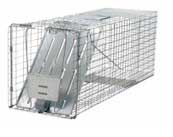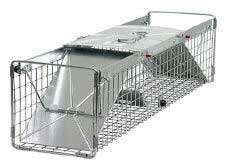Raccoon Traps by HavaHart®
Which trap should I use?
 |
The HAVAHART® brand manufactures two styles of traps: one door and two door. Both styles work equally well and it is truly a matter of preference. The two door style was created with the idea that an animal will not enter a trap if they can not see through to the other side. This is not true as we trap just as many animals in our one door Pro models.
- For trapping raccoons, stray cats, groundhogs (woodchucks), opossums, armadillos, and similar-size nuisance animals
- Collapsible design folds flat for space saving storage
- Smoothed internal edges protect and prevent injuries to animals
- Efficacy proven in extensive field testing means higher catch rate and fewer escapes
- Comes fully assembled and ready to use with Instructions and tips on baits and trap setting included
- Ideal for trapping raccoons, stray cats, groundhogs (woodchucks), opossums, armadillos, and similar-size nuisance animals. Collapsible Havahart traps have a Space Saving Design for easy storage. When ready to use, just lift the handle and the trap pops into place! Constructed of sturdy wire mesh with steel reinforcements for long life, and galvanized for maximum resistance to rust and corrosion. Mesh openings are smaller than competing traps of comparable size to prevent escapes and stolen bait. Spring loaded door and sensitive trigger ensure quick, secure captures. Solid door and handle guard protect user during transportation, while smoothed internal edges protect and prevent injuries to animals. Made in the USA.
 |
What bait should I use for raccoons?
Fish, fresh or canned, honey or sugar covered vegetables, smoked fish, watermelon, sweet corn, cooked fatty meat, crisp bacon. Special favorite of the raccoon is marshmallows!
Where should I place the trap?
Locate the trap in an area where raccoons are often observed. Place the trap on a level surface.
Since raccoons tend to dig all the dirt up under the trap, place the trap on a flat piece of wood. Dispose of the wood after the raccoon is caught.
Position one side of the trap against a wall of a building or in a path commonly traveled by cats.
Before handling the trap, you may want to spray with an insecticide because they often have fleas and ticks. Wear sturdy gloves to cover your hands, since raccoons and skunks carry many diseases. If there are known cases of rabies in your area, we suggest that you contact a professional animal removal service.
How do I set the trap?
Have you lost your instructions? If so, follow the link to see the on-line instructions.
www.havahart.com/nuisance/instructions.htm

